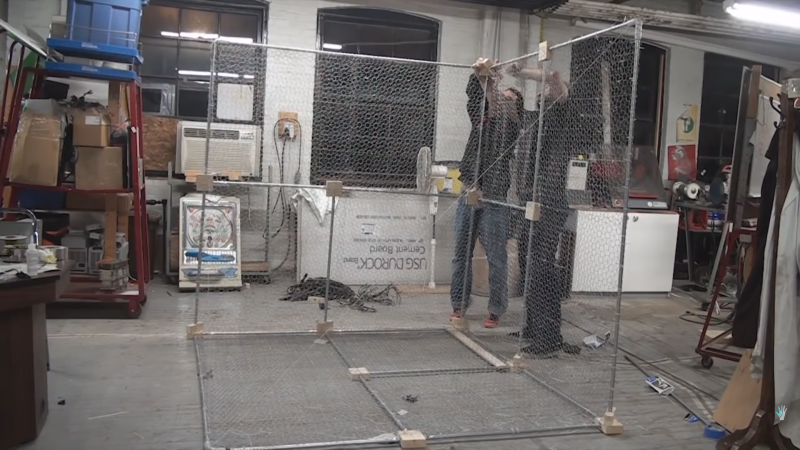Radio waves are received on antennas, for which when the signal in question comes over a long distance a big reflector is needed. When the reception distance is literally astronomical, the reflector has to be pretty darn big. [The Thought Emporium] wants to pick up signals from distant satellites, the moon, and hopefully a pulsar. On the scale of home-built amateur radio, this will be a monstrous antenna. The video also follows the break.
In hacker fashion, the project is built on a budget, so all the parts are direct from a hardware store, and the tools are already in your toolbox or hackerspace. Electrical conduit, chicken wire, PVC pipes, wood blocks, and screws make up most of the structure so put away your crazy links to Chinese distributors unless you need an SDR. The form of the antenna is the crucial thing, and the shape is three perpendicular panels as seen in the image and video. The construction in the video is just a suggestion, but it doesn’t involve welding, so that opens it to even more amateurs.
Even if you are not trying to receive a pulsar’s signature, we have hacks galore for radios and antennas.















Hmm, can’t help but be thinking that his $200 hasn’t been well spent.
Depends.
If you can get a (used) mesh parabolic antenna of a similar size, then I’m sure that it’ll provide a better gain.
But otherwise it won’t be too bad, if you are able to trim it.
Amateur astronomers use corner antennas frequently.
Also, nobody will notice that it’s an antenna, so no neighbor will complain about headaches and insomnia caused by your evil experiments.
If someone asks, you can just tell them, that it’s supposed to be a dog kennel, and you just don’t find the time to complete it.
“If someone asks, you can just tell them, that it’s supposed to be a dog kennel, and you just don’t find the time to complete it.”
Bwahaha I love it.
I usually just go with “It’s a sex thing…” and most people just stop with the inquiry. Only backfires when they get more interested…
xkcd 316
Underrated response. I have to stop lurking for a second just to thank you for making me laugh.
This is a little strange: A typical corner reflector-antenna uses only two planes while three planes give a retroreflector which reflects any incident signal back to it’s source. Like the reflectors on your bicycle.
Maybe each plane (mesh square) is supposed to be inclined 45 degrees away from the source? It should work then, I think …
Chicken wire, wood and PVC pipes are used in professional radio astronomy -see:
http://www.ska.ac.za/media-releases/karoos-hera-radio-telescope-attracts-even-more-international-funding/
Mylar emergency camping blankets are a cheap option for RF and solar reflectors for temporary use.
I had no idea that would work. In the video, he solders all the metal together, is that unnecessary or does the mylar all need to be bonded?
Ideally, yes. But if you were to overlap the seams by several inches it would probably not be required. RF (at those frequencies) will not pass thru a tight seam of a solid sheet of metal film and should not “require” an electrical bond to function. Check out the guy on YouTube that makes solar reflectors out of mylar and pretend he’s talking about RF.
Ha, that’s great. Thank you for the advice
Its a 3D corner reflector. Works very well at WiFi freqs. Amazing gain but it has to be tilted forward at 45 degrees to the incoming signal to work.
Will this work well for several widely different frequencies, or only 144 MHz / 2 m?
Antenna is 2 m size, and he does mention different frequencies will be captured … Never mind.
Can this be considered a low polygon count parabolic reflector?
Part of me thinks yes. Part of me thinks no. Part of me appreciates your humor.
Not if you count all the polygons in that chicken wire.
Some good design info for corner reflector antennas (2-plane type anyway) here: http://www.antenna-theory.com/antennas/reflectors/cornerReflector.php. I am curious to see what “testing” he will do, whether taking actual measurements, or just plug-it-in-and-see-if-it-works kind of testing. Also, why a monopole? And why three planes instead of two?
When the Areceibo Amateur Radio Club used the big dish for 70cm moon bounce a few years ago, I used a pair of old removable window screens to make a corner reflector with a dipole feed to work it. Cost =$0.
Nice hack! Thinking on your feet when it counts.
Copper window screen for higher frequencies.
I don’t even know if you can find copper screen any more. Seems to be all fiberglass now.
And it’s gonna cost a fortune.
But, unlike chicken wire, you can solder the seams.